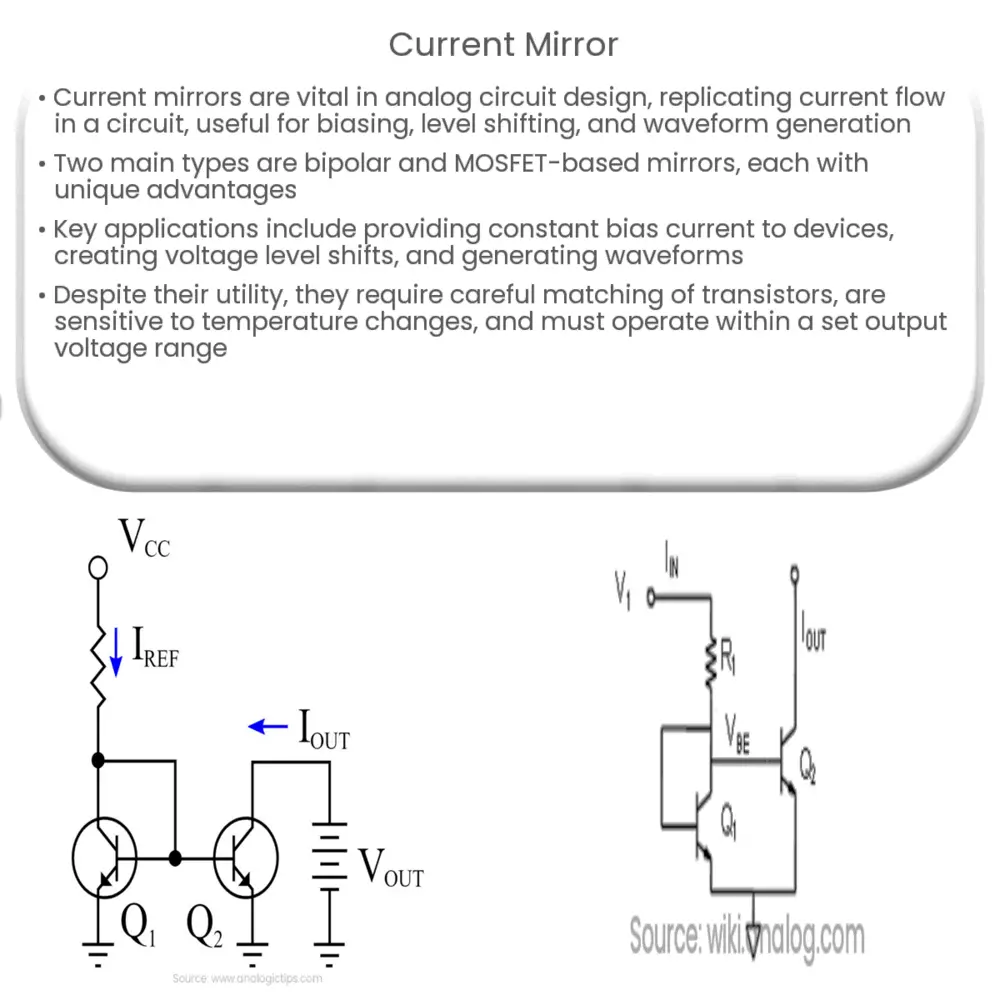A current mirror is a fundamental circuit in analog electronics, replicating a constant current flow between branches for biasing, level shifting, and waveform generation.

Current Mirror: An Essential Component in Analog Circuit Design
Introduction
A current mirror is a fundamental building block in analog electronics, widely used for its ability to maintain a constant current flow in a circuit. In essence, a current mirror is a circuit that replicates or “mirrors” the current flowing through one branch into another. This simple yet powerful concept has numerous applications in analog circuit design, including biasing, level shifting, and waveform generation. In this article, we explore the principles and types of current mirrors, as well as their practical applications and limitations.
Working Principle
At its core, a current mirror consists of two or more transistors connected in such a way that they share the same base-emitter voltage. This configuration ensures that the transistors operate in the active region, meaning their collector currents are primarily determined by their base-emitter voltage and the transistor’s intrinsic properties. As a result, if the base-emitter voltage remains constant, the collector currents of the transistors will be equal or proportional, effectively creating a “mirrored” current flow.
Types of Current Mirrors
There are two main types of current mirrors: bipolar and MOSFET-based. Each type has its advantages and disadvantages, depending on the specific application and design requirements.
Bipolar Current Mirrors
Bipolar current mirrors are built using bipolar junction transistors (BJTs), which provide an output current proportional to their base-emitter voltage. The simplest form of a bipolar current mirror consists of two matched NPN or PNP transistors connected in a common-emitter configuration. The main advantage of bipolar current mirrors is their excellent current replication accuracy, making them suitable for high-precision applications. However, they also exhibit higher base current and power consumption, which can be limiting factors in low-power applications.
MOSFET-based Current Mirrors
MOSFET-based current mirrors utilize metal-oxide-semiconductor field-effect transistors (MOSFETs) to mirror the current. In this configuration, the gate-source voltage of the transistors determines the output current. Due to their voltage-controlled nature, MOSFET-based current mirrors offer lower power consumption and reduced input current, making them ideal for low-power applications. However, their current replication accuracy is typically lower than that of bipolar current mirrors, which may limit their use in high-precision designs.
Applications of Current Mirrors
Current mirrors find extensive use in various analog circuit designs, owing to their ability to maintain a constant current flow. Some common applications include:
- Biasing: Current mirrors can be used to provide a constant bias current to active devices, such as transistors and operational amplifiers, ensuring stable operation and reducing temperature-dependent variations.
- Level Shifting: By mirroring a reference current to generate a voltage drop across a resistor, current mirrors can create level shifts in voltage signals, which are essential in certain analog circuits.
- Waveform Generation: In combination with other circuit elements, current mirrors can help generate complex waveforms, such as sawtooth and triangular waves, by maintaining a constant charging or discharging current.
Design Considerations and Limitations
While current mirrors offer numerous advantages in analog circuit design, they also have certain limitations and design considerations:
Matching and Device Mismatch
To ensure accurate current replication, the transistors used in the current mirror must be closely matched in terms of their characteristics. However, due to manufacturing variations, it is challenging to achieve perfect matching, leading to device mismatch and current errors. In practice, designers often use techniques such as layout matching and current scaling to mitigate the impact of device mismatch.
Temperature Sensitivity
The performance of current mirrors can be affected by temperature variations, as the transistor characteristics change with temperature. This can result in deviations from the desired current replication. To address this issue, designers may use temperature-compensated current mirrors, which incorporate additional components to stabilize the output current across a range of temperatures.
Output Resistance and Compliance Range
The output resistance of a current mirror is an essential parameter, as it determines the mirror’s ability to maintain a constant current over a range of output voltages. A high output resistance is desirable for accurate current replication. However, the compliance range, which is the range of output voltages over which the current mirror can maintain a constant current, is limited by the transistors’ operating regions. Designers must carefully consider these factors when selecting the appropriate current mirror for a specific application.
Advanced Current Mirror Configurations
In addition to the basic current mirror configurations, several advanced designs have been developed to improve performance, such as the Wilson current mirror, the Widlar current source, and the cascode current mirror. These advanced designs offer improved output resistance, reduced temperature sensitivity, and better current replication accuracy, making them suitable for more demanding applications.
Conclusion
Current mirrors are essential components in analog circuit design, providing a simple yet effective means of maintaining constant current flow in various applications. By understanding the principles, types, and limitations of current mirrors, designers can effectively leverage their capabilities to create robust and efficient analog circuits. With continued research and development, advanced current mirror configurations and techniques are expected to further enhance the performance and capabilities of these indispensable components in analog electronics.

